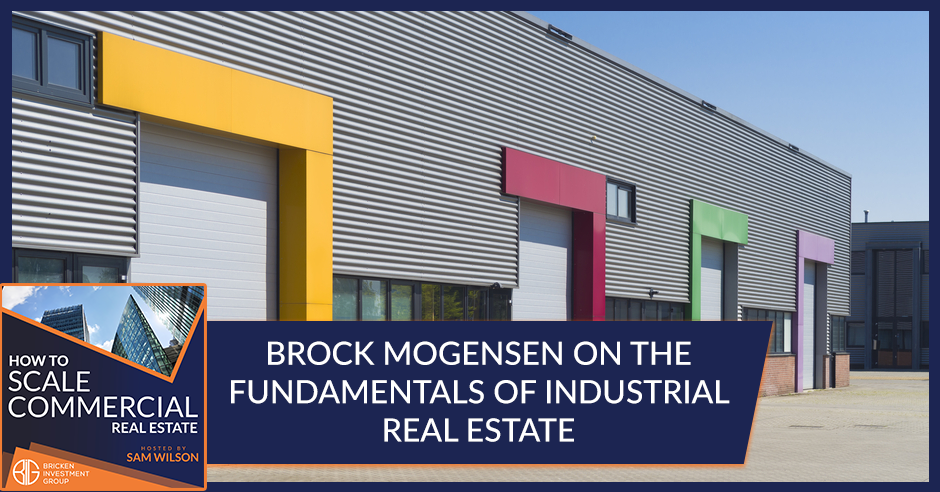Industrial self-storage can be risky, but you just have to learn the fundamentals one by one. You can then stick to one fundamental and grow from there with the power of networking. Joining Sam Wilson today is a Managing Partner at Smart Asset Capital, Brock Mogensen. Brock also specializes in underwriting and incorporating data models for asset management. Join Sam and Brock as they talk about industrial real estate and some of the risks involved. Also, learn a thing or two about real estate underwriting today.
—
Watch the episode here:
Listen to the podcast here:
Brock Mogensen On The Fundamentals Of Industrial Real Estate
Brock Mogensen began investing in real estate years ago. He lives and invests in Milwaukee, Wisconsin, holds a Master’s in Information Systems and comes from an analytical background. He specializes in underwriting and incorporating data models for asset management as a principal at Smart Asset Capital. The firm has $15 million in assets under management. They own everything from multifamily, office, retail, industrial and self-storage. He’s also a Cohost of the largest monthly multifamily meetup in Wisconsin, the Wisconsin Apartment Investors Meetup.
—
Brock, welcome to the show.
Thanks for having me.
The pleasure is mine. Here are the same three questions I ask everybody that come to the show. Can you tell us where did you start? Where you are now? How did you get there?
It started a few years ago with a duplex. I started with the house hack model like a lot of people start and quickly realized how awesome real estate is. You start realizing all the benefits, cashflow and what it does for your taxes. I fell in love with it and decided, “I want to make this my full-time thing. How am I going to scale this much quicker?” As I looked through different avenues, there are a million different ways you can go in real estate. I spent some time researching different ways and syndication was the route I ended up taking. I spent some time learning, partnered with the right people and was able to scale pretty quickly because of it.
Walk us through that process. Was the duplex the last single-family residence you bought?
You don’t have to just stay in your lane and focus on one. It’s okay to keep your net wide.
That was the last deal I bought straight up on my own. Everything since then has been the partnership syndication model.
Talk to us through that process because it’s a tough jump to make for a lot of people, especially starting. You say, “I got one duplex under my belt and I want to go start doing syndications or joint venturing.” Most people are going to say, “You need more experience and X, Y or Z.” How did you overcome that?
I quickly realized that as I’m looking at it, it’s like, “I don’t have the net worth, the experience or all this stuff that’s required to go buy a big apartment complex.” I decided like, “There’s a whole bunch of different pieces that go into syndicating a deal. Let me learn one piece of it and then I’ll take that strong suit, go out and find partners that are looking for someone in that strong suit that is stronger in these other pieces.” I chose the underwriting piece of it.
I naturally came from an analytical background from my W-2 job. That was where I spent 6 months to 1 year learning everything I could, practicing and analyzing deals. I went out, networked and ended up finding people that fit that exact criterion. They were stronger on the capital raising side and had all the experience to go do these deals. It was the right time, right place thing.
Do you still hold that position?
Yeah. Underwriting is still my main focus but as we’ve done more and more deals, you learn the different pieces. At this point, I’m involved in almost every single piece of it. I’m helping on the capital raising and all of that so it has been good to be able to learn everything else.
Talk to us about the types of deals that you buy. You’re all over or at least have your hands dipped it seems at almost every asset class. Are you keeping the net wide still? Have you decided to hyperfocus?

We started with apartments and that was our main focus. It still is but we bought the first big apartment complex and then after that, we get this office deal that falls into our lap so we decided like, “The fundamentals are the same. Let’s buy it.” Next, we get a strip mall that falls into our lap. It was the same thought for us. We bought that and then an industrial building came up. These deals were coming up. They were good deals. We were looking at the numbers and we were like, “Let’s learn it.” We understand the fundamentals of it. There were a few nuances but we can learn it as we go.
That’s how it happened. Since then, I’ve gone into several asset classes and learned the nuances of triple net leases. That’s the main differentiator. It has been good. On the other side, I do see a lot of people say, “Stay in your lane. Focus on one thing.” I get that but for us having a wider net has allowed us to see more deals and transact more. The office is the only thing now that I wouldn’t want to touch. For retail, only if it’s the right retail. There are some risks there still but industrial and self-storage are amazing and apartments are always great.
What do you see on the industrial side?
We’re seeing pretty favorable cap rates. On average, it’s 100 to 200 basis points higher on a cap rate compared to a multifamily and industrial deal. There’s a pretty good spread there. The risk lies in an industrial deal sitting vacant. If you’re looking at a single tenant industrial deal sitting vacant for a year, that’s quickly going to ruin the numbers. Finding the right deals with strong long-term tenants on triple net leases where you can mitigate that risk, account for some vacancy and still hit your numbers is our strategy. We’re seeing more, especially in this Midwest area. There are quite a few demands for industrial so it has been a good ride getting into it.
It sounds like you want to scale that side of your business more.
Partnerships in real estate are a great way to scale, but you still have to do your due diligence.
We’re looking at more of those deals. We’re working on one now so it’s quickly going to end up being the largest percentage of our portfolio within the next few months.
What type of industry is it that you have found is a good niche for you?
As we’re getting more and more into it, that’s something else we’re determining. Is there a certain kind of niche? There are different tenants you can target. The ones we’ve done so far have ranged from workshop industrial where we have a towing and landscaping tenant. What we’re looking at now is more of a manufacturing facility so there are some differences there but overall, we’re looking for deals that are strong, safe and are going to provide good returns.
What has it been like growing your team and your partnership? You said, “This is my skillset.” At the right place, right time, you were able to collaborate with some other people that had other complementary skills. Walk us through that process. What advice would you give to somebody maybe who’s looking to follow in your footsteps?
Partnerships are great. For me, I wouldn’t have been able to get where I am without it. They’re a great way to scale. You have to do your due diligence. You can’t just go out and partner with anyone. You have to vet that person as much as you can on the front end because, realistically, you’re getting into at least a ten-year relationship or a lifelong relationship with this business partner. It’s almost like the person you marry. It’s almost as big as that of a decision.
The biggest thing that I was looking at is, do your goals align? What’s your long-term goal? Are they looking to be in this for a few years, retire and go down to Florida? Do they want to do this for the rest of their lives and they’re looking to build a massive company? Those are the things that can ruin a partnership. If one person is trying to do this and the other person is trying to do that, you want to vet that on the front end to make sure your goals align. You want to make sure you like the person and all that basic stuff but for me, it was making sure we all have the same vision. We want to build this into something big and it worked out.
How many members are on your team now?
There are three of us.
How have you delineated responsibilities? I know you do underwriting. How have you separated it such that you aren’t stepping on each other’s toes or getting in each other’s business as you carry on day-to-day operations?
As we identify the different segments of the business, I’ve spent a lot of time finding and analyzing deals. That’s where most of my time goes, whereas my partners are more on building investor relations and capital. Those are the three things you have to do to buy a deal. On asset management, we have a partner that has his own property management company. That’s a huge value he brought as well as his experience. I spend time on asset management as well. I’ve been wearing several different hats. The goal is to, as you continue to expand, start hiring people and delegating to hire a full-time asset manager. We haven’t quite gotten to that point yet but that is ultimately the goal.
That’s interesting to hear that what you’re thinking is moving forward on that side of things. Talk to us about the retail investments you have done. It’s always an intriguing topic because there are people that pretend to look down on it but it’s not like you were doing small strip center retail investments. Is that right?

That’s correct. The first one we did was a strip mall that has been doing well through COVID. Mostly, it’s because of the tenant base there. That’s a big part of retail, especially now. It is looking at the tenants. That’s one of the big differences between retail and an apartment. The apartment is pretty straightforward for your tenants as long as they did their credit checks on the front end and all that. On a retail asset, you have to dive into these tenants and look at their tenant financials, all these different things and what kind of business are they.
I personally think the service-based tenants are here to stay. If it’s a shoe store, I might be a little scared of that because that stuff’s going all online. It’s taking a macro and micro view of each tenant and determining what’s the risk. There’s more risk in retail than there’s going to be in apartments but generally, you’re able to buy at a better price on retail. It’s all about weighing the risk when it comes to underwriting these assets.
You differentiated between multifamily and retail. In multifamily, we don’t care why someone’s staying there. On the retail side, I care very much as to why you are looking to lease space or occupy a certain segment of a building. Your why has to make sense for you to be there. That’s very interesting. Have you had to tell any tenants no or did you buy all of your buildings at this point fully occupied? What has that process been like?
There have been a few tenants that the space isn’t right. The way they want to outfit the space doesn’t make sense for us so we’ve had to say no in those scenarios. We haven’t had luckily many vacancies or had to deal with many vacancies in our retail stuff so far. There’s one vacancy on the strip mall we bought that is a weird space we haven’t filled yet. The other one we bought was 100% occupied in the retail. That is the tough part to model.
That’s one thing you look at when comparing apartments. In apartments, you can throw in a 5% or 7% vacancy rate right across the board usually and you’re pretty safe. With retail or industrial, if it’s a five-year lease, in year six, are they going to renew or move out? If they move out, how long does it take you to fill that space? For apartments, you can fill that in a couple of weeks. Retail could take a year. That’s where it gets tough. I usually lean towards being very conservative and assuming a year to fill the space. There are different stuff you have to look at. The fundamentals, NOI and all that stuff are the same. It’s just a matter of vacancies and individual leases.
There are a million different ways you can go in real estate, so spend some time researching, learning, and partnering with the right people to scale pretty quickly.
Going back to your business a little bit, this is a question I haven’t asked you yet. What’s a challenge that you are facing in your business? How do you foresee overcoming it?
Finding bigger deals is very competitive. It seems like we’ve fallen into this niche where we’re doing deals in the $2 million to $5 million range. We’re finding good deals there but when we get in the $10-plus million, it’s much more competitive, especially in the multifamily space. It’d be much quicker and easier to scale if we could do larger deals. When you start getting into that point, you start drawing more interest from bigger money sources and it creates more competition. I don’t know if it’s a niche but so far, we’ve stayed in that deal size where I’d like to get to the point where we’re doing the larger deal. It’s just a matter of building the right broker connections.
That’s an interesting point, which begets the next question. Other than economies of scale on the transaction side, what is the compelling reason you want to do bigger deals?
The easy one is it’s more upside for us. That’s the obvious one. It allows for more scale quicker. If we want to expand, hire employees and do all the economies of scale that come with larger deals, doing larger deals is going to further that. Generally, the larger the deals you get either you use more economies of scale or you’re able to support a full-time leasing person at that property. That’s good for investors too. It’s a few different things but it’s ultimately being able to scale quicker.
With economies of scale, when you’re bringing on people and team members, the bigger the deal is, the more revenue there is and the more you can apply it and put more people in the right seats to help drive those deals versus something smaller. Yet, I would wonder on that $2 to $5 million because not as many people are looking there, are the return profiles overall better?
I do think the returns are pretty attractive there and they might even be slightly better. What I’ve seen so far personally and maybe I’m not seeing the right large deals, is they’re pretty good in that size range looking at the returns compared to what the deals I’m seeing in a larger price range. You’re dealing with a lot of times institutional money where they’re fine with a 3% or 4% return where we want to hit 10%. Those are the differences. Again, I’m not saying there are not good, big deals out there. They are out there. It’s a lot of getting in that circle and finding those big deals. It’s a pretty small circle in each market.
One of the challenges that a lot of people have mentioned in the smaller deal size is the financing side of things. It’s easier to find the $20 million deal than it is to find the $2 million deal. How are you overcoming that hurdle?
All but one of our deals has been local commercial bank financing with local connections we have here. The downside is we’re taking on recourse on those loans. We’re able to get pretty attractive terms. You’re not going to have to deal with a lot of the prepayment penalties you might see on some agency or CMBs stuff. That’s pretty attractive.
We have good relationships where if COVID hits and something goes wrong, we can call our guy and say, “Can we do something about this?” You might not have that much flexibility in working with the big banks. The biggest thing is when you get into a larger deal size and you start looking at an agency, CMBs and these different financing options. It’s a non-recourse, which is huge. That’s a big part of it. Generally, you can get some pretty good interest rates and good amortization schedules on those deals. There are benefits and negatives to either one. The non-recourse is the differentiator when you get in these larger deals.
I’ve enjoyed learning about you, what you’re doing and how you’re looking to scale. Let’s fast forward three years. Where would you like your company to be?
I continue seeing us building our base here in the Greater Milwaukee area because of our connection to property management. Three years from now, I’d like to be in other markets across the country in some of the larger, higher-appreciated markets. That’s ultimately the goal. It’s to expand those other markets. Our philosophy was, “Let’s build something big here, take that wrap and go out to other larger markets where we can tow with that and help us get into some of these deals.” Three years from now, I would say that’s the goal.

This has been exciting. Thanks for sharing with us and teaching us about your business, how you have grown it and what you’ve done so far. It has been certainly enlightening. I do appreciate it. Let’s jump here into the final few questions. If you could help our audience to avoid one mistake in real estate, what would it be? How would you avoid it?
One mistake is to always put more money in your replacement reserves at closing than you think you need. If you’re budgeting and you think like, “I might need $50,000 in my account,” put $100,000. Be more conservative and account for more stuff going wrong in your proforma.
When it comes to investing in the world, what’s one thing you’re doing now to make the world a better place?
It’s teaching as many people as I can about how to get the benefits of real estate and everything it can provide in your life. I’ve given out a ton of free educational stuff where I get on calls with people and explain what I’ve done and give back that way. I have much larger goals in the future to give back monetarily but for now, that’s the way in what I’ve done.
If our audience wants to get in touch with you, what is the best way to do that?
My email is Brock@SmartAssetCapital.com. That’s our website. It’s www.SmartAssetCapital.com. Either way, you can get in touch with me in both of those ways.
Thank you. I appreciate your time. Have a great day.
You too.
Important Links:
About Brock Mogensen
 Starting with a duplex in 2018, Brock instantly fell in love with the power of cash flowing real estate as a path towards wealth and true freedom; but he knew he had to find a way to scale quicker. After discovering the concept of syndication, he knew that was the way to do it. Brock spent the next 6 months learning everything he could about underwriting multifamily real estate.
Starting with a duplex in 2018, Brock instantly fell in love with the power of cash flowing real estate as a path towards wealth and true freedom; but he knew he had to find a way to scale quicker. After discovering the concept of syndication, he knew that was the way to do it. Brock spent the next 6 months learning everything he could about underwriting multifamily real estate.
He then took that newfound knowledge and partnered with two experienced investors that sought his underwriting expertise. Fast forward a few years (+analyzing literally billions of dollars worth of deals), and the firm has acquired over $20M in real estate. Throughout that time Brock developed his own model for analyzing deals after discovering that no other tools offered a simple and concise way to analyze a syndicated deal. Now the blueprint is available to you..

